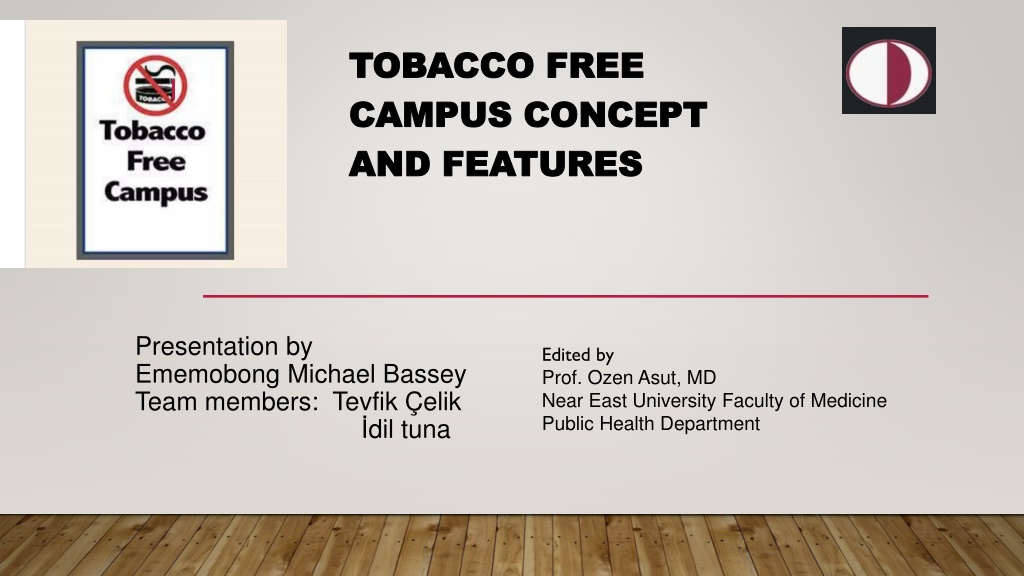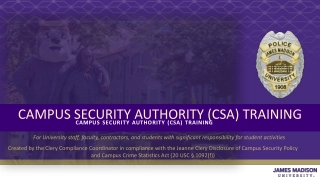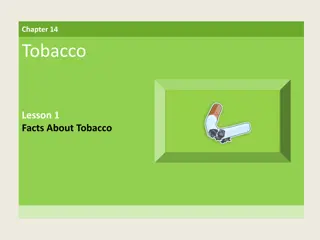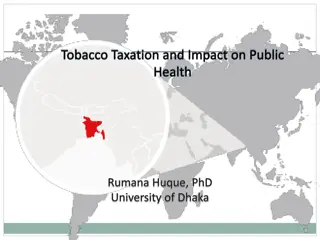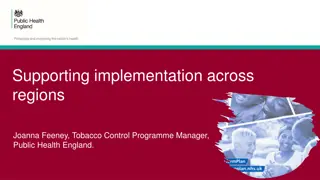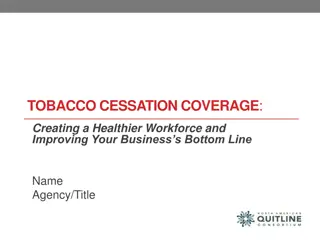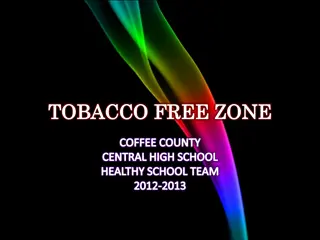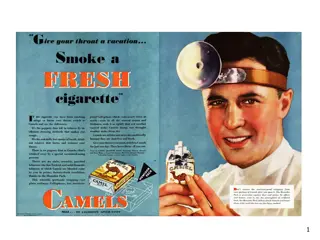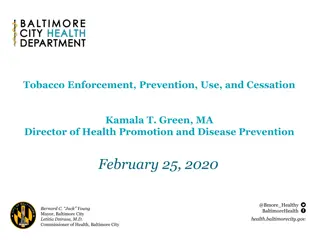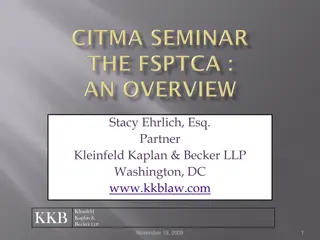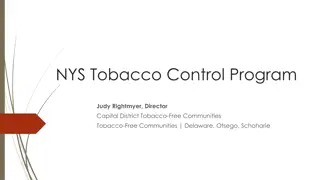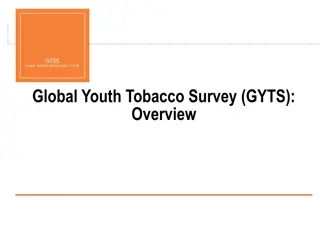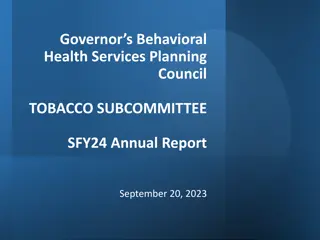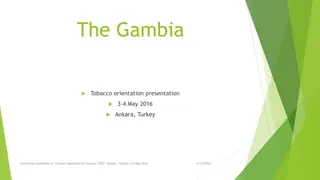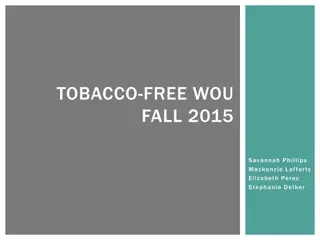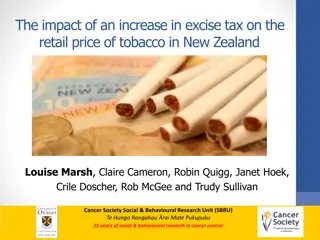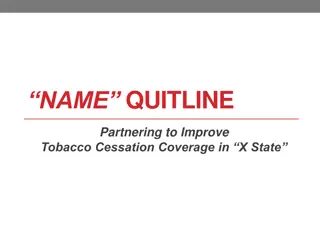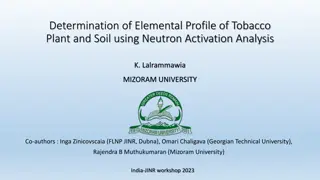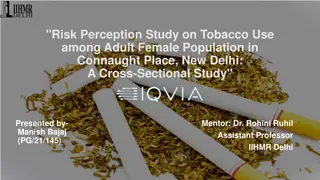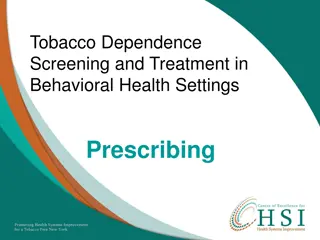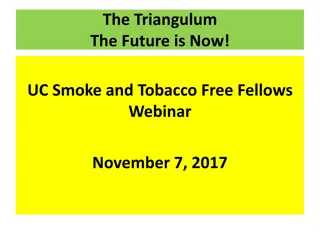Promoting Tobacco-Free Campus: A Health Initiative for Universities
Implementing a tobacco-free campus policy is crucial for creating a healthy learning environment and reducing tobacco use among adolescents and young adults. This presentation highlights the significance of such initiatives, the reasons why young people start smoking, the harmful contents of tobacco smoke, and the dangers of second-hand smoke exposure. By enforcing a tobacco-free campus concept, universities can protect the well-being of their students, faculty, staff, and visitors.
Download Presentation

Please find below an Image/Link to download the presentation.
The content on the website is provided AS IS for your information and personal use only. It may not be sold, licensed, or shared on other websites without obtaining consent from the author. Download presentation by click this link. If you encounter any issues during the download, it is possible that the publisher has removed the file from their server.
E N D
Presentation Transcript
TOBACCO FREE TOBACCO FREE CAMPUS CONCEPT CAMPUS CONCEPT AND FEATURES AND FEATURES 1 Presentation by Ememobong Michael Bassey Team members: Tevfik elik Edited by Prof. Ozen Asut, MD Near East University Faculty of Medicine Public Health Department dil tuna
INTRODUCTION Tobacco use poses significant health risks and negative environmental impacts, making it imperative for universities to foster a healthy and conducive learning environment 2 Implementing a tobacco-free campus policy can contribute to promoting the well-being of students, faculty, staff, and visitors There is significant tobacco use among adolescents and young adults as they are most vulnerable to the exposure to tobacco use Nearly all tobacco use begins during youth and young adulthood Tobacco contains nicotine, a highly addictive drug that causes many young people to progress from smoking occasionally to smoking daily The rates of cigarette smoking among high school juniors and seniors are still higher than those of adults
WHY YOUNG PEOPLE SMOKE 3 * Many kids start using tobacco by age 11. And many are addicted by age14 * The young generations feel proud in smoking and think it adds another feather to their style * Smoking is popular amongst the students who live in hostels, especially * Children and teens are easy targets for the tobacco industry * Teens are often influenced by TV, movies, the Internet, advertising, and their own friends and role models including parents, doctors and celebrities
SECOND-HAND SMOKE KILLS 5 Second-hand smoke is the smoke that fills restaurants, offices or other enclosed spaces when people burn tobacco products such as cigarettes, bidis and water pipes There is no safe level of exposure to second-hand tobacco smoke In adults, second-hand smoke causes serious cardiovascular and respiratory diseases, including coronary heart disease and lung cancer. Almost half of children regularly breathe air polluted by tobacco smoking in public The only way to prevent hazards of passive smoking is to ban smoking in all indoor settings
WHY CHOOSE A TOBACCO-FREE CAMPUS? 6 A tobacco-free campus is more than just a policy It is a commitment to the well-being of all our members Here's why embracing a tobacco-free campus is a positive choice for everyone Improved Health & Wellness: By eliminating tobacco use on campus, we foster a healthier environment for everyone Breathing clean air promotes better respiratory health and reduces the risk of exposure to harmful secondhand smoke, benefiting both smokers and non-smokers Enhanced Learning & Productivity: Studies show that a tobacco-free campus positively impacts academic performance and productivity Setting a Positive Example: As a leading educational institution, adopting a tobacco- free campus policy allows us to set an inspiring example for other universities and the broader community
GUIDELINES FORA TOBACCO FREE CAMPUS 7 1. Conduct a Campus Assessment : Conduct a comprehensive assessment of current tobacco use patterns and attitudes among the campus community Gather data through surveys, focus groups, and consultations to discover the level of support for a tobacco-free initiative. The data will show specific needs of the university community 2. Develop a Clear Policy: Based on the assessment results and best practices from other institutions, create a well-defined tobacco-free policy The policy should be clear, concise, and cover all forms of tobacco use, including smoking, vaping, and smokeless tobacco products Involve key stakeholders, such as students, faculty, staff, and campus administrators, to ensure a sense of ownership and cooperation
GUIDELINES FOR TOBACCO FREE EDUCATIONAL INSTITUTIONS 8 Display of " TOBACCO FREE SCHOOL" or "TOBACCO FREE EDUCATION AL INSTITUTION" Board. Sign board "NO SMOKING AREA- SMOKING HERE Is AN OFFENCE"
9 Anti tobacco slogans in school stationary
GUIDELINES FORA TOBACCO FREE CAMPUS - 2 10 3. Educate and Raise Awareness: Launch an extensive educational campaign to raise awareness about the benefits of a tobacco-free campus. Use flyers, social media, and campus-wide events, to disseminate information about the policy, its rationale, and resources available to support those who want to quit tobacco use. Offer evidence-based information about the health risks of tobacco and the advantages of a tobacco-free environment. 4. Provide Cessation Support: Implement tobacco cessation programs and resources to help individuals who wish to quit tobacco use. Collaborate with campus health services to offer counseling, support groups, and access to nicotine replacement therapy
GUIDELINES FORA TOBACCO FREE CAMPUS -3 5. Enforce Policy with Sensitivity: Enforcement of the tobacco-free policy is crucial, but it should be done with empathy and understanding, using a gradual approach 11 Initiate awareness campaigns about the implementation date, and provide reminders Focus on educating rather than punishing violators, with penalties reserved for repeated offenses 6. Create Designated Smoking Areas: During the transitional period, designate specific smoking areas away from high-traffic locations for those who are not ready to quit, ensuring not undermining the overall goal Engage the Campus Community: Encourage active participation and involvement of students, faculty, and staff in promoting the tobacco-free initiative Establish a student-led task force or committee responsible for organizing awareness campaigns, events, and activities related to the policy
POSTERS EXHBTNG HARMFUL EFFECTS OF TOBACCO 12
GUIDELINES FOR A TOBACCO FREE CAMPUS - 4 13 Sale of tobacco products inside and within the 100 meters from school / campus should be prohibited Smoking or chewing of tobacco inside the premises of institution by students / teachers/ other staff members / visitors should not be permitted in the school "TOBACCO CONTROL COMMITTEE" should be established Tobacco control activities integrated with school health programmes
14 APPROACHES FOR CREATING A SUPPORTIVE COMMUNITY We understand that embracing change may not be easy for everyone That's why we are committed to providing the necessary support and resources to help our members in transition to a tobacco-free campus successfully 1. Cessation Support: For those who are ready to quit tobacco use, our campus health services offer counseling, support groups, and access to proven cessation resources 2. Education & Awareness: We believe that knowledge empowers individuals to make informed choices Our campus-wide awareness campaigns will provide information about the health risks of tobacco use and the benefits of a tobacco-free environment
THE BENEFITS OF NICOTINE- AND TOBACCO-FREE SCHOOL CAMPUSES 15 Within just a few minutes, your body begins a series of changes that continue for years Within 20 minutes, your heart rate and blood pressure drop 12 hours, the carbon monoxide level in your blood drops to normal 2-12 weeks, your circulation improves and your lung function increases 1-9 months, coughing and shortness of breath decrease 1 year, your risk of coronary heart disease is about half that of a smoker s
BENEFITS TO SCHOOLS 16 1. Tobacco-free campuses create a healthier, more productive student body 2. The risk of fire damage, accidents and occupational injuries is reduced 3. Lowers fire and accident insurance premiums 4. Cleaning and maintenance costs also go down 5. Less risk of legal action by non- smoking students due to the adverse health effects of second-hand smoke 6. The image of a school that is committed to a healthier, safer environment and work- place is enhanced 7. It sets a precedent and good example for the community
BENEFITS TO STUDENTS AND TEACHERS 17 1. For smokers, tobacco-free school environments help persuade them to quit entirely 2. Tobacco-free environments de-normalize use of these products to be viewed as socially less acceptable, minimalizing triggers for non-users to initiate 3. For nonsmokers, the risk of health hazards from second-hand smoke is eliminated 4. For both smoking and nonsmoking students and teachers, respiratory and allergic symptoms from tobacco smoke are markedly reduced 5. Other health hazards from exposure to tobacco smoke, such as cancer and heart disease, are also significantly reduced 6. With a healthier learning environment, students are more productive and focused in school 8. Students and teachers in smoke-free work- places lower their risk of exporting third- hand smoke
PLANNING COMMITTEE The Planning Committee should include students, teachers, parents, and staff 18 Sample communication by Planning Committee of activities to be conducted to create a nicotine and tobacco-free campus: The Memo of the Planning Committee s Chairs [insert names of the chairs, and date] has decided the main actions needed to declare [insert name of school] nicotine and tobacco-free, in line with the requirements of Article 8 of the WHO Framework Convention on Tobacco Control (WHO FCTC) and its guidelines for implementation, must include the following: 1.The implementation of an information campaign [name of the campaign, if available], starting [date], until [policy launch date] 2.Awareness raising of the available support mechanisms for smokers who want to quit 3.A public declaration that [name of school] will become nicotine and tobacco-free on [date], and formally close all designated smoking areas
EXAMPLE OF TOBACCO FREE CAMPUS PAMPHLET 19 Dear Members of the University Community, We are excited to introduce our university's commitment to creating a tobacco-free campus environment. This pamphlet aims to highlight the numerous benefits of this initiative and encourage everyone to support this collective effort towards a healthier, safer, and more vibrant university experience. Let's join hands and take a step towards a tobacco-free tomorrow! Join Us in Building a Healthier Future Let's embrace this opportunity to create a healthier and more caring community. By choosing a tobacco- free campus, we invest in the well-being of our students, faculty, staff, and visitors, while fostering a sustainable environment for generations to come. Together, we can make a difference, one step at a time!
REFERENCES Campaign for Tobacco-Free Kids (2019). How Schools Can Help Students Stay Tobacco-Free. (https://www. tobaccofreekids.org/assets/factsheets/0153.pdf, accessed 7 May 2020). 21 WHO Framework Convention on Tobacco Control. Geneva: World Health Organization; 2003. U.S. Department of Health and Human Services. Preventing Tobacco Use Among Youth and Young Adults. Atlanta, GA: U.S. Department of Health and Human Services, Centers for Disease Control and Prevention, Na- tional Center for Chronic Disease Prevention and Health Promotion, Office on Smoking and Health; 2012. Campaign for Tobacco-Free Kids. The Impact of To- bacco Advertising, Promotion and Sponsorship. (https:// www.tobaccofreekids.org/assets/global/pdfs/en/APS_ healthimpact.pdf, accessed 5 March 2020). WHO. E-cigarette Q&A Geneva: World Health Organi- zation; 2020 [Available from: https://www.who.int/news- room/q-a-detail/e-cigarettes-how-risky-are-they. GBD 2017 Risk Factor Collaborators. Global, regional, and national comparative risk assessment of 84 be- havioural, environmental and occupational, and met- abolic risks or clusters of risks for 195 countries and territories, 1990-2017: a systematic analysis for the Global Burden of Disease Study 2017. Seattle, WA: Institute for Health Metrics and Evaluation; 2018. Binkley C. Vaping essays: E-cigarette sellers offering scholarships. AP News; 2018. (https://apnews.com/ a35ba8a0200c4a27943da3b9254b9fe5, accessed 5 March 2020). Kaplan S. Juul targeted schools and youth camps, house panel on vaping claims. New York Times; 2019. (https://www.nytimes.com/2019/07/25/health/ juul-teens- vaping.html, accessed 5 March 2020). WHO. http://www.who.int/tobacco/research/youth/health_effects/en/ CDC. http://www.cdc.gov/tobacco/data_statistic s/sgr/2012/consumer_booklet/pdts/consume r.pdf http://www.ncbi.nlm.nih.gov/pubmed/1840 9317 Cancer. http://www.cancer.org/cancer/cancercaus es/tobaccocancer/childandteentobaccous e/child-by Banner of Sa l k Bilimleri University in Turkey
REFERENCE 22
